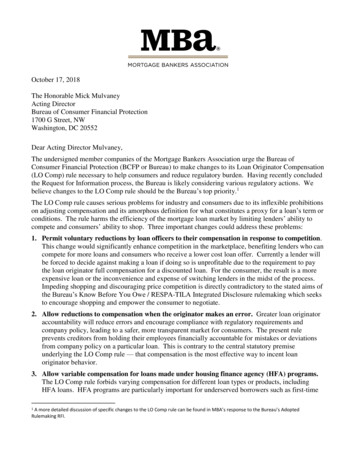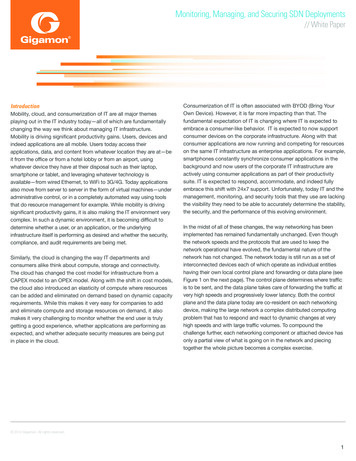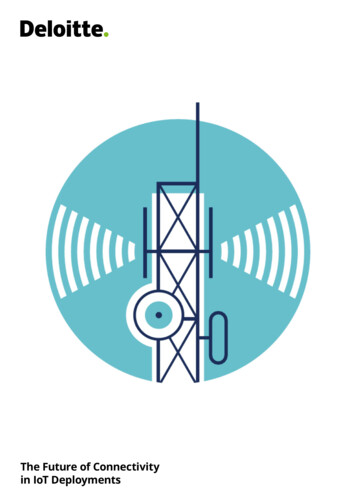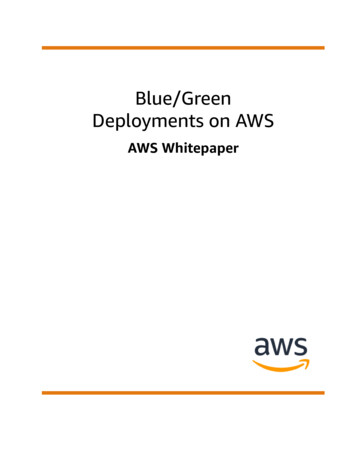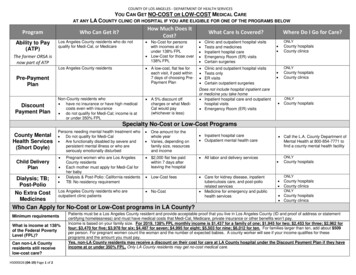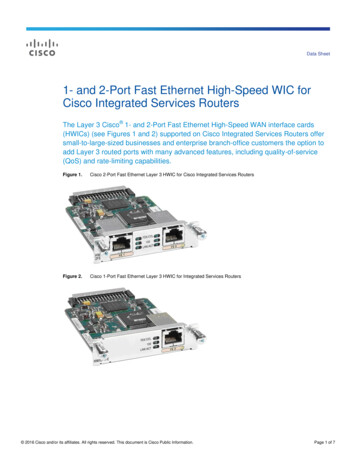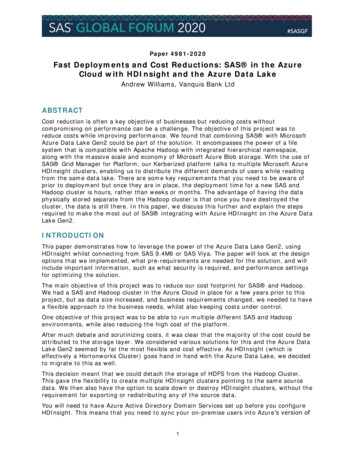
Transcription
Paper 4981-2020Fast Deployments and Cost Reductions: SAS in the AzureCloud with HDInsight and the Azure Data LakeAndrew Williams, Vanquis Bank LtdABSTRACTCost reduction is often a key objective of businesses but reducing costs withoutcompromising on performance can be a challenge. The objective of this project was toreduce costs while improving performance. We found that combining SAS with MicrosoftAzure Data Lake Gen2 could be part of the solution. It encompasses the power of a filesystem that is compatible with Apache Hadoop with integrated hierarchical namespace,along with the massive scale and economy of Microsoft Azure Blob storage. With the use ofSAS Grid Manager for Platform, our Kerberized platform talks to multiple Microsoft AzureHDInsight clusters, enabling us to distribute the different demands of users while readingfrom the same data lake. There are some key requirements that you need to be aware ofprior to deployment but once they are in place, the deployment time for a new SAS andHadoop cluster is hours, rather than weeks or months. The advantage of having the dataphysically stored separate from the Hadoop cluster is that once you have destroyed thecluster, the data is still there. In this paper, we discuss this further and explain the stepsrequired to make the most out of SAS integrating with Azure HDInsight on the Azure DataLake Gen2.INTRODUCTIONThis paper demonstrates how to leverage the power of the Azure Data Lake Gen2, usingHDInsight whilst connecting from SAS 9.4M6 or SAS Viya. The paper will look at the designoptions that we implemented, what pre-requirements are needed for the solution, and willinclude important information, such as what security is required, and performance settingsfor optimizing the solution.The main objective of this project was to reduce our cost footprint for SAS and Hadoop.We had a SAS and Hadoop cluster in the Azure Cloud in place for a few years prior to thisproject, but as data size increased, and business requirements changed, we needed to havea flexible approach to the business needs, whilst also keeping costs under control.One objective of this project was to be able to run multiple different SAS and Hadoopenvironments, while also reducing the high cost of the platform.After much debate and scrutinizing costs, it was clear that the majority of the cost could beattributed to the storage layer. We considered various solutions for this and the Azure DataLake Gen2 seemed by far the most flexible and cost effective. As HDInsight (which iseffectively a Hortonworks Cluster) goes hand in hand with the Azure Data Lake, we decidedto migrate to this as well.This decision meant that we could detach the storage of HDFS from the Hadoop Cluster.This gave the flexibility to create multiple HDInsight clusters pointing to the same sourcedata. We then also have the option to scale down or destroy HDInsight clusters, without therequirement for exporting or redistributing any of the source data.You will need to have Azure Active Directory Domain Services set up before you configureHDInsight. This means that you need to sync your on-premise users into Azure’s version of1
Active Directory. This may sound simple, but there are certain caveats that you will need toaddress first, and some important rules to remember going forward.There is not much difference between connecting to HDInsight and connecting to Hadoop,so while it is a straightforward change for users, there are a couple of important featuresthat this paper will address.The paper will also note which Azure VM’s we recommend to use for the SAS cluster. Wefound that for the SAS Grid environment in particular, performance was high when using theNVMe disks as the SAS Work. The paper will also note any optimizations you can use tospeed up your connection to HDInsight.The end to end deployment of building an HDInsight Cluster, and connecting from a SASenvironment, can be completed under an hour with the aid of automatic deployment, usingscripts via Ansible or similar. This gives users the ability to purchase environments ondemand for independent projects, while keeping costs low due to how the data is stored.BACKGROUNDHaving migrated to Azure a few years ago, after time it became apparent that the ongoingcosts of the platform were not feasible. As with most Cloud providers you do not own theinfrastructure, you pay a monthly fee (you can pay a lower rate if you purchase for one yearor three years). One obvious advantage of using Cloud technology is that if you need toupgrade a server you can do so with a click of a button. However, we were discovering thatthe main cost of the platform was the storage.There were various options with storage in the Cloud: Managed Disks, Storage Blobs, andthe Data Lake. Our existing setup comprised one Hadoop Environment which consisted of 5head nodes and 15 worker nodes, with around 90TB of storage attached. There are differentlevels of Azure Managed Disks (Standard HDD, Standard SSD, Premium SSD), along withdifferent types of redundancy built into the storage. The larger the disk, the more IOPS, andthe higher throughput you will get, although you will pay a premium for this. Therefore, it isimportant to make the right decision if you are going to use Azure Managed Disks becauseyou want optimal performance without paying an excessive amount. With Hadoop however,you want to ensure that you have enough storage to handle the data, and taking intoaccount the replication factor, you need to ensure that you have three times the amount ofstorage you require. Over time costs started to mount, and we only had the one HadoopEnvironment which was not sustainable for development and production. However, byadding another cluster we were potentially looking at doubling our costs.On our existing platform we had only one Hadoop Cluster, and one SAS Environment.Originally this was using SAS Grid on Hadoop, but this was later switched to SAS Grid onPlatform to free up extra resources on the Hadoop Cluster. It would be preferable to havemultiple SAS environments for promotion, and separate development, and productionprocesses.2
Figure 1. Existing PlatformAs shown in Figure 1, on the existing platform, users would log onto a client PC hosted inAzure. They would primarily connect to a single SAS environment, which would talk to asingle Hadoop cluster hosting all the data. All servers are configured to talk back to an onpremise Active Directory for authentication, this is an important note for later in the paper.Our challenge was to create multiple environments for the users whilst reducing costs.DESIGNIt was clear that the Azure Managed Disk costs were not sustainable. Considering thedifferent options offered by Azure, it was a choice between Blob Storage or the Azure DataLake Gen2. The Azure Data Lake Gen2 is built on Blob Storage but you can define POSIXpermissions, so we decided to go with this storage type.AZURE DATA LAKE GEN2The Azure Data Lake Storage Gen2 storage is designed to service multiple petabytes ofinformation while sustaining hundreds of gigabits of throughput. The petabyte service levelsexceeded our needs, but we wouldn’t be far from that requirement in the future. Unlikemost storage offerings from Azure, an important factor of the Data Lake Storage Gen2 isthe addition of a hierarchical namespace. The hierarchical namespace organizes objects/filesinto a hierarchy of directories for efficient data access.You can manage the Data Lake Gen2 via the Azure Portal or Azure Storage Explorer, or liketraditional HDFS, you can run the same commands on the Azure DataLake Gen2, apply ACLpermissions, create directories etc.To access files stored on the Azure Data Lake Gen2 using HDFS commands, you require theABFS driver to be installed (this is generally available within all Apache Hadoopenvironments, including Azure HDInsight, Azure Databricks, and SQL Data Warehouse).The ABFS driver is designed specifically for large data analytics. The corresponding RESTAPIs are connected through the endpoint dfs.core.windows.net.3
Figure 2. Azure Data Lake Gen2 via HDFS commandsUnlike previous Cloud storage options, you can enforce security by defining POSIXpermissions on directories or individual files.CostThe Data Lake Storage Gen2 offers low-cost storage capacity and transactions. With mostCloud providers there is a cost for storing the data, usually separated into different types,HOT, COLD and ARCHIVE, with prices dependent on access requirements.In addition to storage costs, with most cloud providers you will also pay a transaction fee,generally for read and write operations.Built-in features such as Azure Blob storage lifecycle, helps ensure costs are kept to aminimum. When data transitions through a complete lifecycle the billing rates for ADLSGen2 changeWe have reduced our storage costs by approximately 90%, by moving from Premium Disksattached to the Hadoop Cluster, to ADLS Gen2.4
Figure 3. New Platform DesignSAS AND HDINSIGHTThere are various conditions that we need to establish for SAS to work smoothly withHDInsight and the Azure Data Lake.Azure Active Directory Domain ServicesA pre-requirement of HDInsight is to have all users synced into the Azure Active Directory.We already had users syncing to our Azure Active Directory which links applications such asOffice 365. However, a requirement of HDInsight is to secure resources to the Azure ActiveDirectory. Our existing Hadoop environment is currently secured to our on-premise ActiveDirectory, but for HDInsight this isn’t possible.You will need an Azure Administrator for your site to switch this on, which may take a fewhours to sync all of the on-premise directory. Once completed you can then register anyVM’s to Azure AD, and use that as the domain controller.NOTE: Be careful as user passwords will not sync up, so you need to change your password,to then force a sync, and be able to log into an Azure AD secured VM. Also, for on-premiseaccounts where you might have the setting ‘password never expires’, this setting is nolonger valid. You will need to reset the password every 3 months to sync with Azure.Managed IdentityYou will also need to create a managed identity user in Azure. This will be used to registerservice principles and DNS entries for HDInsight, so this will require permission to edit theAzure AD that we have created. You will need to give this account permissions as owner ofthe storage that you are going to use, in this case ADLS Gen2, because all Hive queries bydefault will connect to the storage using this managed identity.5
KerberosHDInsight clusters are secured with Kerberos authentication as default, and this is linked toAzure Active Directory. To avoid cross domain issues or complications you should registerthe SAS Virtual Machines in Azure Active Directory, as opposed to the on-premise ActiveDirectory.We have used SAS Grid with Platform with the normal configuration steps, to allow Kerberosdelegation. There are no special steps required here to access HDInsight.SAS in the Azure CloudWe carried out testing with various types of VMs that Azure offer, there are memoryoptimized VMs or storage optimized. As previously mentioned with regards to disks, thelarger VM you select the better IOPS you will have, but obviously this will cost you more.We settled on the below configuration following copious testing:Metadata 3x E8s v3 (8 vcpus, 64 GB memory)Grid 3x L16s V2 (16 vcpus, 128 GiB memory, NVMe 2x1.TB (used for SAS Work 400-500read/write mb/s)Midtier 2x E16s v3 (16 vcpus, 128 GiB memory)For the SAS Grid (where most of your execution will happen), the L Series are by far thebest performers if you use the NVMe (/mnt/resource) that comes with the hosts. We foundthat adding disks to the host and using SAS Work will not yield the same performance.DEPLOYMENT AND CONFIGURATIONHDINSIGHTTo create HDInsight clusters, you can simply go onto the Azure Portal, fill in a few pages ofinformation, and then deploy. If you are happy with the settings then you can save these toa file and redeploy via an Azure Script in Powershell etc. or make a call and deploy inAnsible. Then you have an automated method of creating an Hadoop Cluster, with theability to clone the clusters, or create in the morning before users log on, and destroy in theevening, if you don’t want to pay to have it running overnight.MetastoreTo reduce manual tasks, if you are going to destroy and recreate your HDInsight clustersmultiple times, then it is a good idea to create a SQL database. This must be a SQLdatabase in Azure. The advantage of this is that tables and database Metadata and Rangerpolicies can be stored away and kept for future use. We have used the same SQL databasefor each of our clusters. The reason for this is that if we spin up a new cluster, then it isextremely easy to grant access to a database as the Metastore is already active. We justneed to give the Ranger permissions to see the table or database. If you decide to use thismethod, then ensure that your Hive databases are unique if you have multiple HDInsightclusters.FileSystemsOnce you have created an Azure Data Lake Gen2 Storage Account, your HDFS filesystemwill be created inside a storage container. You should have separate containers for eachHDInsight cluster you create, these can be under the same Azure Data Lake Gen2 StorageAccount. This is the method that we have deployed. It gives the ability to create a cluster on6
demand to a set of users if required and have access to data from a different cluster, or in ashared storage container.It is important to note that while HDInsight can talk to multiple storage containers in thesame Azure Data Lake Gen2 account, it can only talk to one Azure Data Lake Gen2 accountat a time. This is worth noting for any design considerations.When deploying HDInsight, HDInsight can create the container if it doesn’t previously exist.Note of caution on this, when running the SAS Hadoop tracer script, this may fail as it isrequired to run commands against ADLS and connect to Ambari resources. You can howeverrun the script as the Hive user directly via command line.SecurityAs previously mentioned, when deploying HDInsight, it is best to point the Ranger databaseto an existing SQL database to keep permissions when clusters are destroyed andrecreated. When deploying you will need to select which AD Groups you wish to use to syncusers onto the platform. Traditionally, you would point your cluster to an OU to gather theusers. However, in this instance you simply select which group(s) to use. It is importanthere to select all of the users that you need. By default, all users will have the samepermissions when you create the cluster on the first occasion, with the requirement toselect any Ambari Admin permissions after creation.CONNECTING SAS TO HDINSIGHTYou will find the process of connecting SAS to HDInsight similar to that of connecting SAS tomost Hadoop providers. However, there are a few points to be aware of to ensure that thisruns smoothly, and to avoid any unexpected errors.Hadoop TracerAs with the Hadoop Tracer supplied by SAS, you can either run via the SAS DeploymentWizard, or copy the Hadoop Tracer onto the Hadoop cluster, and run from there. WithHDInsight we have found that it is much easier to run the command on the HDInsightcluster, rather than from the SAS Deployment Wizard.The Hadoop Tracer module will run a set of scripts which are used to collect JAR and XMLfiles from HDInsight, these will then enable SAS to connect to HDInsight through a Libnamestatement or the Pass-Through Facility.If you plan on destroying your HDInsight cluster at the end of the day then you are going tofind that your JAR and CONF files may be out of date. Microsoft have added slight updatesto JAR files so you should ensure that you have the latest if you rebuild the cluster.When running the script each time, if you use Zookeeper to connect from SAS you will findthat some of the host names have changed. For example, when you first build the cluster itmay be zk0,zk1,zk2, but upon rebuilding the hosts may be zk0,zk3,zk5.When running the Hadoop Tracer script, you will need to be an admin in Ambari, as it runscertain commands. Also, you will have to be able to run HDFS commands on the ADLSfilesystem which will read and write to certain locations. You have two choices; you can runthe script as the Hive user, or, if you create the ADLS filesystem prior to deploying then youcan add a service account, which will inherit read/write/execute permissions on anythingcreated.Remember that your data doesn’t have to be stored in the same ADLS Gen2 container asyour default filesystem.7
Run as End User v Run as HiveIf you are familiar with Hadoop, most companies will ensure that all Hive queries run as theend user. This allows you to set user limits and restrict how much processing power oneuser can take up, to allow a fair use policy.HDInsight works a bit differently if you are going to use the Azure Data Lake Gen2 as well.Firstly, by default everything is configured to run as the Hive user (remember this uses themanaged identity to connect to ADLS Gen2), for ease of use. As the filesystem is createdfrom scratch, it won’t know which user groups to secure it with. By default, it is secured toonly allow the managed identity to read the data on ADLS Gen2. If you destroy and thenrecreate the cluster, the filesystem will remain so that any changes to permissions will bekept for future clusters created.If you want everything to run as the end user, then you will need to apply user/grouppermissions to the Data Lake, either in Storage Explorer, HDFS ‘setfacl’ commands, or viaPowershell commands.You will need to ensure that within directories such as athistory, tmp, and other directoriesin the ADLS Gen2 filesystem, users have the appropriate read and write permission.On the container level, users or groups will need to be granted read and executepermission.Finally, in the location where Hive databases are stored, the required permissions for reador write access will be needed to be granted to the appropriate group(s) or user(s).DNS EntriesAs we know, the managed identity is responsible for adding the cluster nodes and serviceaccounts into Active Directory. Then your SAS Virtual Machines can use the Active DirectoryDNS name of the nodes to communicate.However, on ‘cluster destroy’ these entries are not removed. If you build a new cluster withthe same name, then you will find that the IP addresses stored in your AD are different.The options are either to have an Azure Admin at your site remove the entries before yourecreate the cluster, or you can copy the hosts file from one of the HDInsight nodes to yourSAS Virtual Machines.Log into Ambari firstWhen using SAS or Beeline to connect to Hive via JDBC and read data, this will work fine.However, when it comes to writing data to Hive, this is a different story. After submittingyour query, after around 30 minutes, it will reply with the below error regarding token notfound:ERROR: Status code: -1 error code: null error TokenNotFoundException: Tokendoes not exist in TokenManager (Response Code: 404)This is because you need to generate an OAuth token to be able to communicate with theADSL Gen2 storage. One way to do this is to log into Ambari URL. You will need to do thiseach time that the cluster is created. The user logon for this is your full email address, thesame that you would use to log into the Azure Portal, or your email online.8
The workaround that we have for this is to add the following code into the SAS Autoexec.This will then make a HTTP call to the Amabri URL and using the password and emailaddress stored in SAS Metadata, complete the authentication behind the scenes for ourusers.filename resp TEMP;filename headers TEMP;proc httpmethod "POST"url "https://p
effectively a Hortonworks Cluster) goes hand in hand with the Azure Data Lake, we decided to migrate to this as well. . The Azure Data Lake Storage Gen2 storage is designed to service multiple petabytes of information while sustaining hundre
